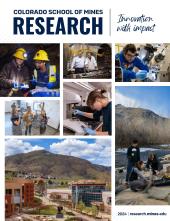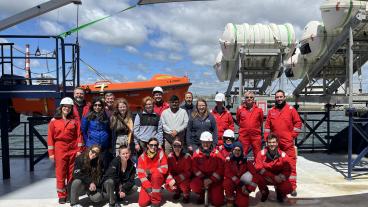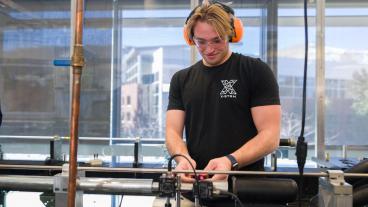Mines researchers developing materials for aerospace technologies
Metallurgical and Materials Engineering, Mechanical Engineering faculty helping to redefine what's possible in aviation, space exploration


As the aerospace industry reaches new heights, the demand for advanced materials has never been more critical. Traditional materials often fall short in meeting the rigorous demands of modern aerospace applications.
Mines stands at the center of this innovation. Renowned for its expertise in materials science and engineering, the university closely collaborates with aerospace companies and organizations to foster an environment where academic research and industrial application intersect. Researchers are leading projects to advance aircraft and space technologies that can withstand extreme temperatures and stress and take on new environments beyond Earth.
Here are just a couple ways Mines researchers are helping redefine what’s possible in aviation and space exploration.
New materials for more reliable engine assembly and repairs
Aerospace technologies like airplane engines, turbines and key components in rockets have to withstand incredibly harsh working environments and high temperatures. The immense wear and tear on these components critically shorten their lifespan and requires frequent—and often expensive—repairs.
Traditional filler materials used to bond aerospace components together during assembly or repair often display less-than-optimum performance, which further shortens the lifespan of these systems.
To address this issue, Zhenzhen Yu, associate professor of metallurgical and materials engineering, and her research team developed a novel filler material using multi-principal element alloys (also known as high entropy alloys) to improve both the properties and lifetime of joining and repair materials within aerospace technologies. These filler materials can withstand harsh environments while being much less expensive than traditional materials.
“The high-entropy alloy concept cameout in the early 2000s, but people have just been looking at it as a structural material. We thought there could be great opportunity for it to serve as a joining or repair material,” Yu said.
Yu’s team designed a number of high entropy alloy fillers with superior properties that enable considerable lifetime extension of the bonded parts.They have since commercialized their fillers, which are being evaluated for adoption and replacement of what is currently being used.
“There hasn’t been significant advancement in improving the properties of these materials in probably 70 years,” Yu said. “That’s why we said, ‘Why don’t we design something completely novel?’ ”
Material compatibility for applications beyond Earth
Space exploration often faces constraints due to the limited resources and technology that can be sent from Earth. But Mines researchers are leveraging their expertise in extracting and utilizing Earth’s materials to identify and process resources found in space and develop technologies to propel humanity’s capabilities for further and deeper exploration beyond Earth.
“Mines is a unique university that is very oriented toward natural resources—identifying them and making them into useful things, whether that’s materials or energy,” said Chris Dreyer, professor of practice in mechanical engineering. “That’s exactly what we’re doing with space resources, but it’s in a unique environment where identifying resources, processing them into useful things and doing so within the limitations of a space mission is a challenge.”
This emphasis on identifying resources and processing methods requires approaches that ensure the longevity and functionality of these materials for advanced applications.
“We are looking at things like material compatibility to design reactors that can last for a long time, and it has unique requirements that you don’t typically see in equivalent terrestrial applications,” Dreyer explained. “Particularly, we want materials that can last a long time rather than being replaced or refurbished after a few uses. We want them to last long enough to do a productive piece of work, like produce a certain amount of oxygen that will help keep a crew alive or refuel a propulsion system or produce enough metal to use in a productive way, like building a habitat.
“Space resources is really an upcoming technology area that will enable entirely new things in space.”




